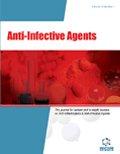Abstract
A simple method based on hydrolysis of 2,3-dicyanopyrazinium salts has been used for the synthesis of the corresponding 5-(hetero)aryl-3-cyano-1-ethyl-2(1H)-pyrazinones. Also, the series of novel 1-ethyl-5-(hetero)aryl-1,6-dihydropyrazine-2,3-dicarbonitriles have been obtained through reduction of the same pyrazinium salts with triethylsilane. The obtained compounds proved to be active in micromolar concentrations in vitro against Mycobacterium tuberculosis H37Rv, Mycobacterium avium, Mycobacterium terrae, as well as against rifampicin and isoniazid-resistance strains of Mycobacterium tuberculosis. The data for acute in vivo toxicity in mice have been obtained for these compounds which appear to be promising antitubercular agents.
Keywords: Pyrazine, 2(1H)-Pyrazinone, antituberculosis activity, tuberculosis, mycobacterium avium, mycobacterium terrae.
Graphical Abstract
Anti-Infective Agents
Title:Synthesis and Antitubercular Evaluation on Novel 1-Ethyl-5-(hetero)aryl- 1,6-dihydropyrazine-2,3-dicarbonitriles and 3-Cyano-1-ethyl-5-(hetero) aryl-2(1H)-pyrazinones
Volume: 14 Issue: 2
Author(s): Marionella A. Kravchenko, Egor V. Verbitskiy, Sergey N. Skornyakov, Pavel A. Slepukhin, Gennagy L. Rusinov, Oleg N. Chupakhin and Valery N. Charushin
Affiliation:
Keywords: Pyrazine, 2(1H)-Pyrazinone, antituberculosis activity, tuberculosis, mycobacterium avium, mycobacterium terrae.
Abstract: A simple method based on hydrolysis of 2,3-dicyanopyrazinium salts has been used for the synthesis of the corresponding 5-(hetero)aryl-3-cyano-1-ethyl-2(1H)-pyrazinones. Also, the series of novel 1-ethyl-5-(hetero)aryl-1,6-dihydropyrazine-2,3-dicarbonitriles have been obtained through reduction of the same pyrazinium salts with triethylsilane. The obtained compounds proved to be active in micromolar concentrations in vitro against Mycobacterium tuberculosis H37Rv, Mycobacterium avium, Mycobacterium terrae, as well as against rifampicin and isoniazid-resistance strains of Mycobacterium tuberculosis. The data for acute in vivo toxicity in mice have been obtained for these compounds which appear to be promising antitubercular agents.
Export Options
About this article
Cite this article as:
Kravchenko A. Marionella, Verbitskiy V. Egor, Skornyakov N. Sergey, Slepukhin A. Pavel, Rusinov L. Gennagy, Chupakhin N. Oleg and Charushin N. Valery, Synthesis and Antitubercular Evaluation on Novel 1-Ethyl-5-(hetero)aryl- 1,6-dihydropyrazine-2,3-dicarbonitriles and 3-Cyano-1-ethyl-5-(hetero) aryl-2(1H)-pyrazinones, Anti-Infective Agents 2016; 14 (2) . https://dx.doi.org/10.2174/2211352514666160728160218
| DOI https://dx.doi.org/10.2174/2211352514666160728160218 |
Print ISSN 2211-3525 |
| Publisher Name Bentham Science Publisher |
Online ISSN 2211-3533 |
 33
33 2
2 1
1 1
1
- Author Guidelines
- Bentham Author Support Services (BASS)
- Graphical Abstracts
- Fabricating and Stating False Information
- Research Misconduct
- Post Publication Discussions and Corrections
- Publishing Ethics and Rectitude
- Increase Visibility of Your Article
- Archiving Policies
- Peer Review Workflow
- Order Your Article Before Print
- Promote Your Article
- Manuscript Transfer Facility
- Editorial Policies
- Allegations from Whistleblowers
- Announcements
Related Articles
-
Latent Tuberculosis: Is There a Role for Thioridazine?
Recent Patents on Anti-Infective Drug Discovery The Importance of Bioactivation in Computer-Guided Drug Repositioning. Why the Parent Drug is Not Always Enough
Current Topics in Medicinal Chemistry MICA Gene and Relevance to Immune Responses in Organ Transplants and Inflammatory, Tumoral and Autoimmune Diseases
Current Immunology Reviews (Discontinued) Radziszewski Reaction: An Elegant, Easy, Simple and Efficient Method to Synthesise Imidazoles
Current Organic Synthesis Synthetic Methods Applied in the Preparation of Coumarin-based Compounds
Current Organic Chemistry Surfactant Protein A - From Genes to Human Lung Diseases
Current Medicinal Chemistry Computational Methods for the Prediction of Microbial Essential Genes
Current Bioinformatics New Imaging Tracers for the Infected Diabetic Foot (Nuclear and Optical Imaging)
Current Pharmaceutical Design Agrobacterium-Mediated Transient Expression as an Approach to Production of Recombinant Proteins in Plants
Recent Patents on Biotechnology Interplay between Catalysts and Substrates for Activity of Class Ib Aminoacyl-tRNA Synthetases and Implications for Pharmacology
Current Topics in Medicinal Chemistry Impairment of T Cell Immunity by the Respiratory Syncytial Virus: Targeting Virulence Mechanisms for Therapy and Prophylaxis
Current Medicinal Chemistry Recent Developments in Oral Bait Vaccines for Wildlife
Recent Patents on Drug Delivery & Formulation FtsZ: A Novel Target for Tuberculosis Drug Discovery
Current Topics in Medicinal Chemistry Laccase Regulators in Anti-fungal Drug Discovery: Dark Lessons from the AIDS-related Pathogen, Cryptococcus
Current Enzyme Inhibition An Updated Review of ISCOMSTM and ISCOMATRIXTM Vaccines
Current Pharmaceutical Design Obesity and the Aging Respiratory System
Current Respiratory Medicine Reviews Genetic and Molecular Factors in Drug-Induced Liver Injury: A Review
Current Drug Safety The Multifaceted Activities of Mammalian Defensins
Current Pharmaceutical Design Patent Selections:
Recent Patents on Inflammation & Allergy Drug Discovery Ligustrazine Derivatives. Part 8: Design, Synthesis, and Preliminary Biological Evaluation of Novel Ligustrazinyl Amides as Cardiovascular Agents
Medicinal Chemistry


























